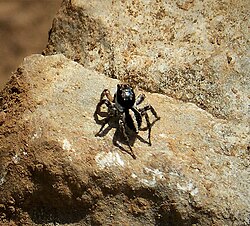Biology:Aelurillus mirabilis
| Aelurillus mirabilis | |
|---|---|

| |
| The related Aelurillus v-insignitus | |
| Scientific classification | |
| Domain: | Eukaryota |
| Kingdom: | Animalia |
| Phylum: | Arthropoda |
| Subphylum: | Chelicerata |
| Class: | Arachnida |
| Order: | Araneae |
| Infraorder: | Araneomorphae |
| Family: | Salticidae |
| Subfamily: | Salticinae |
| Genus: | Aelurillus |
| Species: | A. mirabilis
|
| Binomial name | |
| Aelurillus mirabilis Wesołowska, 2006
| |
Aelurillus mirabilis is a species of jumping spider in the genus Aelurillus that lives in Namibia. It was first described in 2006 by Wanda Wesołowska. The species is medium-sized to large, with a dark brown carapace that is between 2.6 and 3.6 mm (0.10 and 0.14 in) long and a fawn abdomen that is between 2.2 and 3.3 mm (0.087 and 0.130 in) long. The spider has an indistinct marking of two brown streaks on the abdomen, which is nearly invisible on the female. It is unusual in the genus for the lack of central depression and sclerotized flaps at the top of the copulatory openings in the female epigyne. This, along with the shape of the male copulatory organs with their distinctive coiled embolus, enable the spider to be differentiated from others in the genus.
Taxonomy
Aelurillus mirabilis is a jumping spider species first described by Wanda Wesołowska in 2006.[1] It is one of over 500 species identified by the Polish arachnologist during her career.[2] It was tentatively placed in the genus Aelurillus, although Wesołowska was initially wary of the allocation due to the difference of some of the features of both the male and female from the rest of the genus, first described by Eugène Simon in 1885.[3] The genus name derives from the Greek word for cat and the species name is derived from the Latin for strange.[4][5] The genus was placed in the subtribe Aelurillina in the tribe Aelurillini, both named after the genus, by Wayne Maddison in 2015. These were allocated to the clade Saltafresia.[6] In 2017, the genus was grouped with nine other genera of jumping spiders under the name Aelurillines.[7]
Description
The spider is medium-sized to large and hairy. The male has a dark brown pear-shaped carapace that measures between 2.6 and 3 mm (0.10 and 0.12 in) in length and between 1.9 and 2.1 mm (0.075 and 0.083 in) in width. It is covered with whitish grey hairs and scattered long brown bristles. The abdomen is round and fawn in colour with two faint brown streaks, between 2.2 and 2.5 mm (0.087 and 0.098 in) long and 1.7 and 2.0 mm (0.067 and 0.079 in) wide. The base of the abdomen is whitish yellow. The eye field is black has short hard spines towards the front which decrease in size towards the back. The clypeus is brown and the chelicerae are dark yellow with a one very small tooth visible. The spinnerets are brown, thin and long, and the legs are short and range from dark yellow and light brown. The pedipalps are yellow with greyish white hairs.[3] with some small white hairs. The palpal bulb is brown, has two distinctive protuberances and a single projection that extends from the central area of the bulb. The embolus is coiled and hidden so only the tip is visible.[5] The shape of the copulatory organs differentiate the species from others in the genus.[3]
The female is similar to the male in shape but slightly larger. It has an carapace 3.2 to 3.6 mm (0.13 to 0.14 in) long and 2.4 to 2.8 mm (0.094 to 0.110 in) wide and an abdomen that is between 2.6 and 3.3 in (66 and 84 mm) long and 2.4 to 2.9 mm (0.094 to 0.114 in) wide.[3] The colouring is similar, although the brown markings on the abdomen are even more indistinct. The epigyne has a large pocket and two fissure-like copulatory openings. The insemination ducts are very broad and the recepticles spherical.[5] It is unusual in the genus for the lack of central depression and sclerotized flaps at the top of the copulatory openings.[3]
Distribution
The spider is endemic to Namibia.[1] The species was first identified in the area around the Brandberg Mountain, based on a male holotype and multiple female and male paratypes collected in 2000.[3]
References
Citations
- ↑ 1.0 1.1 World Spider Catalog (2017). "Aelurillus mirabilis Wesolowska, 2006". Natural History Museum. http://www.wsc.nmbe.ch/species/28000. Retrieved 27 March 2017.
- ↑ Wiśniewski 2020, p. 6.
- ↑ 3.0 3.1 3.2 3.3 3.4 3.5 Wesołowska 2006, p. 226.
- ↑ Fernández-Rubio 2013, p. 125.
- ↑ 5.0 5.1 5.2 Wesołowska 2006, p. 228.
- ↑ Maddison 2015, p. 279.
- ↑ Prószyński 2017, p. 95.
Bibliography
- Fernández-Rubio, Fidel (2013). "La etimología de los nombres de las arañas (Araneae)" (in ES). Revista ibérica de Aracnología (22): 125–130. ISSN 1576-9518.
- Maddison, Wayne P. (2015). "A phylogenetic classification of jumping spiders (Araneae: Salticidae)". The Journal of Arachnology 43 (3): 231–292. doi:10.1636/arac-43-03-231-292.
- Prószyński, Jerzy (2017). "Pragmatic classification of the World's Salticidae (Araneae)". Ecologica Montenegrina 12: 1–133. doi:10.37828/em.2017.12.1.
- Wesołowska, Wanda (2006). "Jumping spiders from the Brandberg massif in Namibia (Araneae: Salticidae)". African Entomology 14: 225–256. https://hdl.handle.net/10520/EJC32698.
- Wiśniewski, Konrad (2020). "Over 40 years with jumping spiders: on the 70th birthday of Wanda Wesołowska". Zootaxa 4899 (1): 5–14. doi:10.11646/zootaxa.4899.1.3. PMID 33756825.
Wikidata ☰ Q1873269 entry
 |

